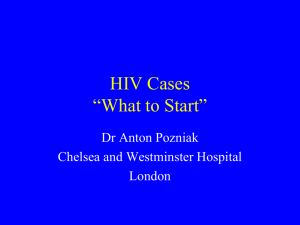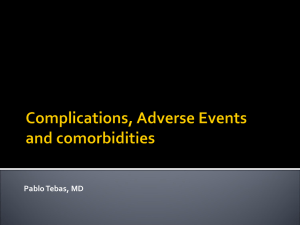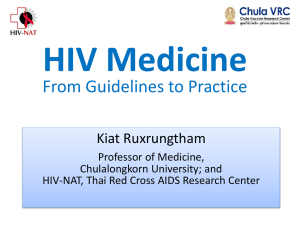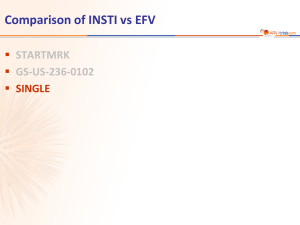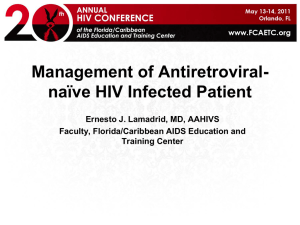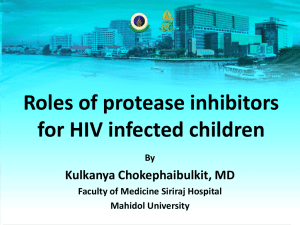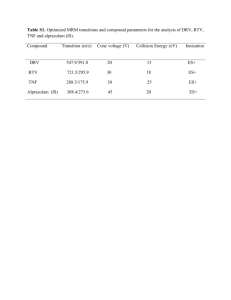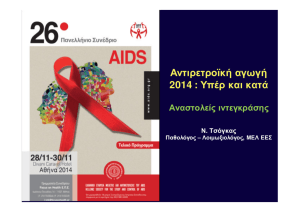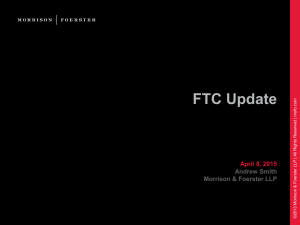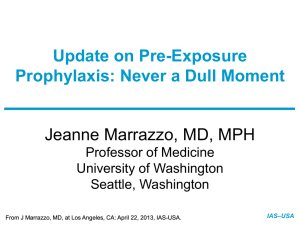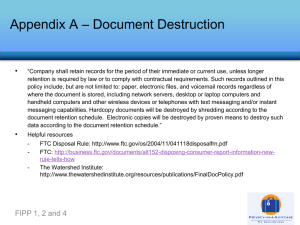THIS IS THE HEADLINE STYLE - ADAP Advocacy Association
advertisement
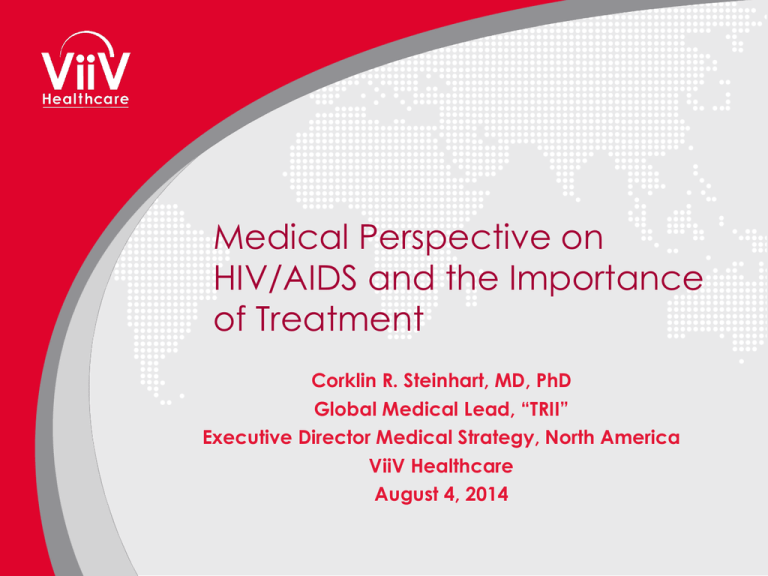
Medical Perspective on HIV/AIDS and the Importance of Treatment Corklin R. Steinhart, MD, PhD Global Medical Lead, “TRII” Executive Director Medical Strategy, North America ViiV Healthcare August 4, 2014 Thanks to Clinical Care Options (Dr. Paul Sax) and to Dr. Andrew Carr for the use of some slides Take Home Messages •The HIV virus “sets up shop” in the human body within hours of infection •HIV is a chronic viral infection •Question: why would you want a viral infection to cause relentless damage to your body before beginning effective cART? •All guidelines are changing to begin therapy regardless of CD4 count: it’s about time! •HIV therapy is needed for life at this time •Is there a place for newer and better ARVs and strategies? • Yes, because currently there are no perfect ARVs or strategies! •If you take the medicines, they work: ADHERENCE is the key to success! “OK. I’m done! Any questions?” Major reduction in AIDS-mortality inequalities after HAART: Fig. 1 Age and sex-adjusted (European population was used as standard) AIDS mortality rates (per 100,000 person-years) in population aged 20–49 years. Region of Madrid (Spain), 1990–2003. Social Science &amp; Medicine, Volume 68, Issue 3, 2009, 419 - 426 http://dx.doi.org/10.1016/j.socscimed.2008.10.039 JAMA. 2014; 312 (4): 410-425 Antiretroviral Therapy Update 2014 Paul E. Sax, MD Clinical Director Division of Infectious Diseases Brigham and Women’s Hospital Professor of Medicine Harvard Medical School Boston, Massachusetts Supported by educational grants from multiple commercial supporters. CHOICE OF INITIAL 3RD ART DRUG ART guidelines DHHS, 20141 TDF/FTC EFV EACS, 20142 EFV RPV* EFV RPV ATV/r DRV/r TDF/FTC EFV RPV* ABC/3TC EFV TDF/FTC ATV/r DRV/r ABC/3TC ATV/r DRV/r ABC/3TC ATV/r TDF/FTC RAL EVG/c TDF/FTC ABC/3TC TDF/FTC TDF/FTC ABC/3TC NRTIs ATV/r DRV/r DTG EVG/c RAL DTG NNRTI IAS-USA, 20143 TDF/FTC TDF/FTC ABC/3TC PI/r INI WHO, 20134 TDF/FTC TDF/3TC EFV DTG EVG/c RAL DTG 1. DHHS Guidelines for the Use of Antiretroviral Agents in *For patients with HIV-1 RNA <100,000 c/mL HIV-1-Infected Adults and Adolescents, May 2014 DHHS, Department of Health and Human Services; EACS, European AIDS Clinical Society; IAS-USA, 2. EACS Guidelines Version 7.02, June 2014 International Antiviral Society USA Panel; WHO, World Health Organization; TDF/FTC tenofovir/emtricitabine; EFV, efavirenz; ABC/3TC abacavir/lamivudine; RPV, rilpivirine; 3. Günthard HF, et al. JAMA 2014;312:410-425 ATV/r, atazanavir/ritonavir; DRV/r, darunavir/ritonavir; DTG, dolutegravir; EVG/c, elvitegravir/cobicistat; 4. WHO guidelines for the use of antiretroviral drugs RAL, raltegravir; NRTIs, nucleoside reverse transcriptase inhibitors; NNRTI, non-nucleoside reverse for treating and preventing HIV infection, June 2013 transcriptase inhibitor; PI/r, boosted protease inhibitor; INI, integrase inhibitor DESIRABLE ATTRIBUTES OF NEW AGENTS AS PART OF A FIRST-LINE TREATMENT REGIMEN Highly potent antiviral activity Favourable resistance profile No food requirements ARV Simple regimen Low PK variability and predictable exposureresponse relationship ARV, antiretroviral; PK, pharmacokinetic Safe and generally well tolerated Once-daily administration without a PK enhancer DHHS Guidelines for the Use of Antiretroviral Agents in HIV-1-Infected Adults and Adolescents, May 2014 24th Annual CCO HIV and Hepatitis C Symposium clinicaloptions.com Extensive New Data on Integrase-Based First-line Therapy The following DTG studies all presented and/or published in past yr – SPRING-2 – SINGLE – FLAMINGO TDF/FTC/EVG/COBI: no new cases of renal tubulopathy in long-term f/u ACTG 5257: raltegravir vs boosted PIs 24th Annual CCO HIV and Hepatitis C Symposium clinicaloptions.com Dolutegravir Clinical Trials in TreatmentNaive Pts Randomized, noninferiority phase III studies Primary endpoint: HIV-1 RNA < 50 c/mL at Wk 48 SPRING-2[1] (placebo controlled) ART-naive pts VL ≥ 1000 c/mL (N = 822) SINGLE[2] (placebo controlled) ART-naive pts VL ≥ 1000 c/mL HLA-B*5701 neg CrCl > 50 mL/min (N = 833) FLAMINGO[3] (open label) ART-naive pts VL ≥ 1000 c/mL (N = 484) DTG 50 mg QD + 2 NRTIs* (n = 411) RAL 400 mg BID + 2 NRTIs* (n = 411) DTG 50 mg QD + ABC/3TC QD (n = 414) EFV/TDF/FTC QD (n = 419) DTG 50 mg QD + 2 NRTIs* (n = 242) DRV/RTV 800/100 mg QD + 2 NRTIs* (n = 242) *Investigator-selected NRTI backbone: either TDF/FTC or ABC/3TC. 1. Raffi F, et al. Lancet. 2013;381:735-743. 2. Walmsley S, et al. N Engl J Med. 2013;369:1807-1818. 3. Clotet B, et al. Lancet. 2014;[Epub ahead of print]. 24th Annual CCO HIV and Hepatitis C Symposium clinicaloptions.com Proportion of Patients (%) SINGLE: Dolutegravir + ABC/3TC vs Efavirenz/TDF/FTC in Tx-Naive Pts DTG + ABC/3TC 100 EFV/TDF/FTC DTG: 80% 80 60 EFV: 72% Wk 96 adjusted difference in response (95% CI): +8.0% (+2.3% to +13.8%); P = .006 40 CD4 ∆ from BL 20 0 0 4 8 12 16 Wk 96 ∆ From BL Adjusted Mean SE DTG + ABC/3TC QD (n = 414) 325.3 10.5 EFV/TDF/FTC QD (n = 419) 281.4 10.9 Treatment 24 32 40 48 Wk 60 72 Difference in Response (95% CI) 44.0 (14.3, 73.6) P = .004 84 96 DTG superior to EFV at Wk 48[1] and Wk 96[2] Treatment-related study d/c: 3% in DTG vs 11% in EFV arm at Wk 96; comparable rates of virologic failure (6% in each arm at Wk 96) No resistance in DTG arm through Wk 9 1. Walmsley S, et al. N Engl J Med. 2013;369:1807-1818. 2. Walmsley S, et al. CROI 2014. Abstract 543. 24th Annual CCO HIV and Hepatitis C Symposium clinicaloptions.com Activity of Integrase-Based Therapies Maintained at High HIV-1 RNA STARTMRK[1] SPRING-2[4] Difference, % (RAL-EFV) and 95% CI In favor of EFV ≤ 100,000 c/mL > 100,000 c/mL -20 -10 Difference, % (DTG-RAL) and 95% CI 0 10 20 30 -20 -10 In favor of EVG/COBI 0 5 10 15 In favor of EVG/COBI 0 5 30 -20 -10 0 10 20 30 FLAMINGO[5] Difference, % (EVG/COBI-ATV/RTV) and 95% CI -15 -10 -5 20 In favor of DTG In favor of EFV ≤ 100,000 c/mL > 100,000 c/mL Study 103[3] In favor of ATV/RTV ≤ 100,000 c/mL > 100,000 c/mL 10 Difference, % (DTG-EFV) and 95% CI Difference, % (EVG/COBI-EFV) and 95% CI -15 -10 -5 0 SINGLE[4] Study 102[2] In favor of EFV ≤ 100,000 c/mL > 100,000 c/mL In favor of DTG In favor of RAL ≤ 100,000 c/mL > 100,000 c/mL In favor of RAL 10 15 Difference , % (DTG-DRV/RTV) and 95% CI In favor of DRV/RTV ≤ 100,000 c/mL > 100,000 c/mL -20 -10 In favor of DTG 0 10 20 1. Lennox J, et al. Lancet. 2009;374:796-806. 2. Sax PE, et al. Lancet. 2012;379:2439-2448. 3. De Jesus E, et al. Lancet. 2012;379:2429-2438. 4. Brinson C, et al. CROI 2013. Abstract 554. 5. Feinberg J, et al. ICAAC 2013. Abstract 1464a. 30 40 24th Annual CCO HIV and Hepatitis C Symposium clinicaloptions.com Increased Risk of Suicidality Associated With EFV 5% .05 Efavirenz Efavirenz-free Probability .04 HR (95% CI) 2.28 (1.27-4.10), P = .006 .03 47 events/5817 PY* (8.08/1000 PY) .02 .01 15 events/4099 PY* (3.66/1000 PY) 0 As-treated HR 2.16 (1.16-4.00) 0 24 48 72 96 120 144 Wks to Suicidality *Person-years, sum of at-risk follow-up. Mollan K, et al. IDWeek 2013. Abstract 40032. 168 192 24th Annual CCO HIV and Hepatitis C Symposium clinicaloptions.com ACTG 5257: Open-Label ATV/RTV vs RAL vs DRV/RTV in First-line ART Stratified by HIV-1 RNA < or ≥ 100,000 c/mL, participation in metabolic substudy, CV risk Wk 96 after last patient enrolled ATV/RTV 300/100 mg QD + TDF/FTC (n = 605) ART-naive patients with HIV-1 RNA ≥ 1000 c/mL (N = 1809) Primary endpoints – – RAL 400 mg BID + TDF/FTC (n = 603) DRV/RTV 800/100 mg QD + TDF/FTC (n = 601) Virologic failure: time to HIV-1 RNA > 1000 c/mL (at Wk 16 or before Wk 24) or > 200 c/mL (at or after Wk 24) Tolerability failure: time to discontinuation of randomized component for toxicity – Composite endpoint: the earlier occurrence of either VF or TF in a given participant – Switch of regimens allowed for tolerability Landovitz R, et al. CROI 2014. Abstract 85. 24th Annual CCO HIV and Hepatitis C Symposium clinicaloptions.com ACTG 5257: Primary Endpoint Analyses at Wk 96 Virologic Failure Tolerability Failure Regimens equivalent in time to VF ATV/RTV vs RAL 3.4% (-0.7 to 7.4) DRV/RTV vs RAL 5.6% (1.3 -9.9) DRV/RTV vs RAL 3.6% (1.4-5.8) 10 20 In part due to high proportion of pts with hyperbilirubinemia Favors RAL ATV/RTV vs RAL 13% (9.4-16.0) Considering both efficacy and tolerability, RAL superior to either boosted PI DRV/RTV superior to ATV/RTV Favors RAL ATV/RTV vs RAL 15% (10-20) Favors RAL DRV/RTV vs RAL 7.5% (3.2-12.0) Favors DRV/RTV ATV/RTV vs DRV/RTV 7.5% (2.3-13.0) Favors DRV/RTV ATV/RTV vs DRV/RTV 9.2% (5.5-13.0) ATV/RTV vs DRV/RTV -2.2% (-6.7 to 2.3) 0 Significantly greater incidence of treatment failure with ATV/RTV vs RAL or DRV/RTV – -10 Composite Endpoint -10 0 10 20 -10 0 Difference in 96-Wk Cumulative Incidence (97.5% CI) Landovitz R, et al. CROI 2014. Abstract 85. Reproduced with permission. 10 20 Novel Strategies for Treatment 24th Annual CCO HIV and Hepatitis C Symposium clinicaloptions.com 3 Active Drugs—Not 2, Not 4—Have Been the Sweet Spot for Initial HIV Treatment Studies With 2-Drug Strategies Studies With 4-Drug Strategies DMP-066 ACTG 5095 ACTG 5142 ACTG 5173 SPARTAN COL40263 ACTG 5162 RADAR PROGRESS A4001078 None to date offers compelling evidence to move from 3-drug approach. 24th Annual CCO HIV and Hepatitis C Symposium clinicaloptions.com LATTE: Study Design Phase IIb, randomized, multicenter, partially blind, dose-ranging study comparing S/GSK744 plus RPV to EFV plus NRTIs HIV-1 ART-naive HIV-1 RNA > 1000 c/mL 1:1:1:1 randomization Stratified by VL and NRTI Oral Induction Phase Oral Maintenance Phase 744 10 mg + 2 NRTIs* 744 10 mg + RPV 25 mg 744 30 mg + 2 NRTIs* 744 30 mg + RPV 25 mg 744 60 mg + 2 NRTIs* 744 60 mg + RPV 25 mg EFV 600 mg + 2 NRTIs* D1 Wk 16 20 24 48 *ABC/3TC or TDF/FTC. Patients on 744 + NRTI: If Wk 20 VL < 50 c/mL, simplify to 744/RPV at Wk 24. Margolis D, et al. EACS 2013. Abstract PS7/1. 72 96 24th Annual CCO HIV and Hepatitis C Symposium clinicaloptions.com 744 + RPV Regimen Maintained Suppression Comparable to EFV-Based Therapy Induction Phase 100 744 OR Wk 24 87% 744 OR Wk 48 82% Maintenance Phase Proportion, % 80 60 EFV response Wk 48 71% EFV response Wk 24 74% 40 Median (IQR) Change From BL CD4+ Cell Count (Cells/mm3) Wk 48 744 overall +219 (141,343) EFV +227 (134,369) 20 0 BL 2 4 744 10 mg (N = 60) 8 12 16 744 30 mg (N = 60) Margolis D, et al. CROI 2014. Abstract 91LB. 24 26 28 32 36 Wk 744 60 mg (N = 61) 40 48 EFV 600 mg (N = 62) Investigational Drugs 24th Annual CCO HIV and Hepatitis C Symposium clinicaloptions.com Tenofovir Alafenamide: Summary and What’s Coming Phase II and preclinical data suggest the following potential benefits – Reduced renal and bone toxicity – Lower dose allows smaller pill, novel coformulations – Possible activity vs some TDF-resistant strains Phase III studies of “ECF-TAF” or “Quad-II” fully enrolled Development of TAF/FTC and TAF/FTC/DRV/COBI planned 24th Annual CCO HIV and Hepatitis C Symposium clinicaloptions.com HIV-1 RNA < 40 Copies/mL (%) Doravirine vs EFV Phase II: 24-Wk Results 100 80 MK-1439 all doses combined: 76.4% 80.0 76.2 71.4 78.0 64.3 60 40 20 32/40 32/42 30/40 32/41 27/42 MK-1439 50 mg MK-1439 100 mg MK-1439 200 mg Efavirenz 600 mg 0 MK-1439 25 mg Morales-Ramirez J, et al. CROI 2014. Abstract 92LB. GSK744 LA Is Formulated as a 200 mg/mL Nanosuspension GSK1265744 (GSK744) F O N H F H N O N O OH O Dolutegravir F O N H F H N O N O OH O 1. Müller et al. Eur J Pharm Biopharm. 2011;78:1-9. 2. Spreen et al. IAS 2013; Kuala Lumpur, Malaysia. Abstract WEAB0103.3. Min et al. ICAAC 2009; San Francisco, CA. Abstract H-1228. 4. Taoda et al. International Congress on Drug Therapy in HIV Infection 2012; Glasgow, Scotland. Abstract P206. Andrews et al. CROI 2014; Boston, MA. Abstract 39. Pharmacokinetic Evaluation of a Single Intramuscular GSK744 LA Injection in Human Volunteers Plasma GSK744 (µg/mL) 10 200 mg 400 mg 800 mg 1 4X PAIC90 1X PAIC90 0.10 0.01 0 4 8 12 16 20 24 28 32 36 40 44 48 52 Time (weeks) Adapted from Spreen et al. IAC 2012; Washington, DC. Abstract TUPE040. Andrews et al. CROI 2014; Boston, MA. Abstract 39. 24th Annual CCO HIV and Hepatitis C Symposium clinicaloptions.com Drugs With Novel Mechanisms for Pan-Resistant HIV in Phase II or Later BMS-663068 (attachment inhibitor) It is therefore critical that patients with highly resistant virus preserve virologic suppression through excellent adherence! Lalezari J, et al. CROI 2014. Abstract 86. Adherence as a Driver for Treatment Success MSD Satellite Symposium EACS Belgrade, Oct 12 2011 cART 4 life – the patient marathon • Long-term adherence is difficult: Toxicities, side effects, co-morbidities, mental health • Non-adherence is dangerous: Resistance risk • Individual adherence barriers: Drug or alcohol use, Problems at work or in relationships, readiness relapse • System related barriers: Insurance coverage, stockouts, stigmatisation ADHERENCE “The bottom line is this: if patients take their meds they will do well!” Assuming they are all available…. 24th Annual CCO HIV and Hepatitis C Symposium clinicaloptions.com Antiretroviral Therapy: What to Expect in the Next 12 Mos Coformulated ABC/3TC/DTG Coformulated DRV/COBI Coformulated ATV/COBI Phase III data of TAF/FTC/EVG/COBI Additional data on long acting parenteral formulations Other key data? 24th Annual CCO HIV and Hepatitis C Symposium clinicaloptions.com Antiretroviral Therapy in 2014: Conclusions Treatment has become the cornerstone of HIV prevention Data on integrase inhibitor–based initial therapies are increasingly favorable 2-drug strategies should generally be avoided pending further data Drugs in development may offer improvements in safety, tolerability, convenience Take Home Messages •The HIV virus “sets up shop” in the human body within hours of infection •HIV is a Chronic Viral Infection •Question: why would you want a viral infection to cause relentless damage to your body before beginning effective cART? •All guidelines are changing to begin therapy regardless of CD4 count: it’s about time! •HIV therapy is needed for life at this time •Is there a place for newer and better ARVs and strategies? • Yes, because currently there are no perfect ARVs or strategies! •If you take the medicines, they work: ADHERENCE is the key to success! Thanks very much
